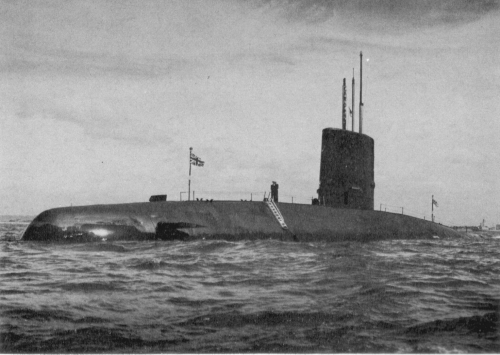

Dreadnought 1963
| Name | No | Yard No | Builder | Laid down | Launched | Comp | Fate |
| Dreadnought | S101 | Vickers-Armstrong, Barrow | 12.6.1959 | 21.10.1960 | 17.4.1963 | for disposal 1982 |
|
Displacement standard, t |
3000 |
|
Displacement normal, t |
3500 / 4000 |
|
Length, m |
81.0 pp 89.5 oa |
|
Breadth, m |
9.80 |
|
Draught, m |
7.90 |
|
No of shafts |
1 |
|
Machinery |
2 sets English Electric geared steam turbines, Westinghouse / Rolls-Royce S5W nuclear reactor |
|
Power, h. p. |
15000 |
|
Max speed, kts |
15 / 28 |
|
Fuel, t |
nuclear |
|
Endurance, nm(kts) |
practically unlimited |
|
Armament |
6 - 533 TT (bow, 24) |
|
Electronic equipment |
type 1002 radar, type 2001, type 2007, type 2019 sonars, UAA ECM suite, DCA CCS |
|
Complement |
88 |
|
Diving depth operational, m |
230 |
Project history: Although plans for a nuclear submarine had been in embryo as early as 1943, a Government directive to the Admiralty to wait until the land-based nuclear power stations were ready meant that nothing could be done until the mid-1950s. Delays with the British Dounreay reactor threatened to delay the programme even further, and so in 1958 the US Nary was asked to supply a Westinghouse S5W reactor of the same type as in the Skipjack class. This meant that the after end of Dreadnought is virtually an adaptation of that design to British industrial practice grafted on to British equipment and weapon systems, although a considerable amount of information about advanced British design procedures was supplied to the USN in exchange.
The reactor was built by Rolls-Royce and the turbines by English Electric. She was fitted with Type 2001 sonar in the 'chin' position. Type 2007 for long-range passive detection and Type 2019 for ranging and interception. Because Dreadnought has one shaft and rudder, all the TT were forward.
Modernizations: None.
Naval service: Early in 1982 it was announced that she had reached the end of her hull life and would be laid up after her reactor had been dismantled and the core removed.

Dreadnought 1977
© Ivan Gogin, 2015